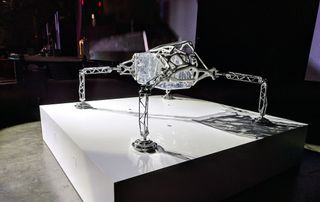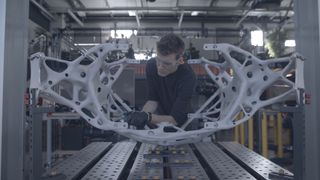
These Organic-Inspired Planetary Landers Could Help NASA Reach Other Worlds

NASA's Jet Propulsion Laboratory (JPL) and Autodesk, a software company, have engaged in a multiyear collaborative research project to investigate new approaches for building interplanetary landers.
The concept lander, perhaps the most complicated structure ever created using "generative design," was unveiled today (Nov. 13) at Autodesk University, a conference being held this week in Las Vegas.
Design solutions
Generative design is a relatively new approach that uses machine intelligence and cloud computing to quickly generate a broad set of design solutions that fit within the specific constraints set by engineers. It enables design teams to explore a much wider design space while still being bound by manufacturing and performance requirements dictated by the team or environment, according to an Autodesk statement.
A commercial form of generative-design technology is available today in Fusion 360, Autodesk's cloud-based product development platform.

Organic-looking shapes
Generative design is often associated with 3D printing, also known as additive manufacturing, which is well-suited for the complex, organic-looking shapes that the software produces based on user specifications.
For the lander project, the JPL team is using experimental generative-design technology for multiple structural components, including the internal structure that holds the scientific instruments and the external structure that connects the lander legs to the main payload box. The team has been able reduce the mass of the external structure by 35 percent compared with the baseline design they started with.

New designs quickly
A key benefit of generative design is that it enabled the JPL team to iterate their designs rapidly.
Get the Space.com Newsletter
Breaking space news, the latest updates on rocket launches, skywatching events and more!
"As a design matures and new performance or environmental data comes in, generative design can enable our customers to create new designs quickly," Karl Willis, Autodesk's technology lead on the project, said in the statement.
Most design teams typically take two to four months to turn around a revised design. But by working with generative design, Willis added, that process can take place in just two to four weeks.
Leonard David is author of "Mars: Our Future on the Red Planet," published by National Geographic. The book is a companion to the National Geographic Channel series "Mars." A longtime writer for Space.com, David has been reporting on the space industry for more than five decades. Follow us @Spacedotcom or Facebook. This version of the story published on Space.com.
Join our Space Forums to keep talking space on the latest missions, night sky and more! And if you have a news tip, correction or comment, let us know at: community@space.com.

Leonard David is an award-winning space journalist who has been reporting on space activities for more than 50 years. Currently writing as Space.com's Space Insider Columnist among his other projects, Leonard has authored numerous books on space exploration, Mars missions and more, with his latest being "Moon Rush: The New Space Race" published in 2019 by National Geographic. He also wrote "Mars: Our Future on the Red Planet" released in 2016 by National Geographic. Leonard has served as a correspondent for SpaceNews, Scientific American and Aerospace America for the AIAA. He has received many awards, including the first Ordway Award for Sustained Excellence in Spaceflight History in 2015 at the AAS Wernher von Braun Memorial Symposium. You can find out Leonard's latest project at his website and on Twitter.
